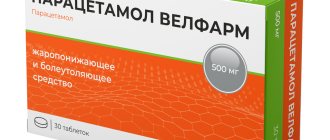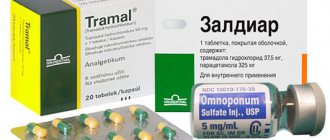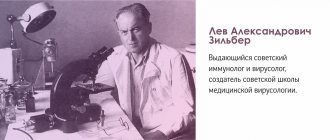- General information
- Historical facts
- Effect on the body
- How to recognize a drug addict
- Tests for tramadol
- How long does it stay in the body?
- How long do drug addicts live?
- Analogs
- How to speed up elimination at home
- Detoxification in hospital
- Overdose
- How to recognize
- First aid
- Rehabilitation
- Coding
- Why you can’t undergo rehabilitation at home or on an outpatient basis
- Working with codependents
- How to quit on your own
- Resocialization
Attention! Drug use causes irreparable harm to health and poses a danger to life!
General information
Tramadol or Tramal is an analgesic from the group of synthetic opiates. It is used in the fight against pain after fractures or soft tissue injuries. It is indicated for pain relief in stage 3-4 cancer, after surgical and trauma operations.
Tramadol is prescribed to patients over 14 years of age. It is produced in the form of ampoules, rectal suppositories and tablets. The medicine causes rapid physical and psychological dependence, which is why it is included in the register of especially dangerous drugs. In the Russian Federation, the drug is sold in pharmacies only with a prescription.
In pharmaceutical doses in short courses, the drug does not cause destruction of internal organs. If the dose exceeds the permissible dose by 2 times, addiction to the drug will form in 2-3 doses.
Compared to opium, tramal has a weaker effect. In order to get the effect of injecting opiate drugs, drug addicts take 5-10 tablets at a time. This may cause overdose and death due to respiratory depression.
Within a few months of using tramadol, a person’s personality is completely destroyed. He constantly needs to take the drug, and without a new dose, a pronounced withdrawal syndrome begins, which is accompanied by pain.
Opiate addicts use Tramal to reduce withdrawal symptoms after quitting heroin or opium. But this only delays the onset of withdrawal symptoms, transforming dependence from one drug to another.
Substituting tramadol for opiate drugs is life-threatening. In an attempt to get the desired effects from the pills, drug addicts continually increase their dosage and run the risk of death due to respiratory arrest or acute liver failure.
In what cases is Tramadol prohibited?
The use of analgesics in all forms is excluded in case of individual intolerance to the active and auxiliary substances, alcohol abuse or poisoning, or dependence on psychoactive substances. Other contraindications:
- suicidal tendencies, severe clinical depression;
- renal and liver failure;
- undergoing treatment with certain psychotropic drugs;
- epilepsy that cannot be corrected with medications;
- first trimester of pregnancy.
In late pregnancy and lactation, Tramadol is prescribed in exceptional cases for individual indications.
Historical facts
The drug entered the pharmaceutical market in 1962 thanks to the German company. Dr. Kurt Flick was responsible for all studies on the effects of the drug.
Due to its pronounced analgesic effect, tramadol began to be prescribed more often than all other analgesics. But due to widespread use, cases of drug addiction began to be noted, and soon most countries banned the sale of the drug without a prescription. There are approximately 70 million prescriptions for Tramadol.
In Russia, Belarus, and Ukraine, Tramadol is sold only by prescription. In Asia and South Africa, the drug can be purchased at any pharmacy. This leads to massive pharmaceutical drug addiction.
In most European countries, Tramadol is used in combination with other drugs or to ease withdrawal after an amphetamine “marathon”, during heroin withdrawal, which is life-threatening, and even to relieve a hangover.
Consequences of taking tramadol
Since tramadol becomes rapidly addictive, drug addicts exhibit characteristic behavioral signs. For each patient these are individual characteristics, but the main ones can be identified:
- mood swings, memory impairment;
- sleep disturbance, indifference to appearance;
- the appearance of debts and dubious friends.
In addition, redness of the eyes and constriction of the pupils, changes in skin color or the appearance of a rash on it, a staggering gait, and excessive gesticulation are observed.
Long-term use of the drug provokes the destruction of bone tissue, bones become weak and often break. Use of the drug for two years or more leads to the occurrence of diseases such as cirrhosis of the liver, hepatitis, epilepsy, dementia and other mental disorders.
Poisoning with the drug causes vomiting, fainting, and epileptic seizures. At the same time, vision deteriorates, the heartbeat slows down, and it becomes difficult to breathe. The patient in such a situation is required to undergo a detoxification process, which lasts several weeks. This can be done by contacting the specialists at the IMC clinic. Complete refusal to take this synthetic drug in combination with medications specifically prescribed by the doctor contributes to a full recovery. But this abstinence process is very long.
Tramadol is considered a drug in many countries, so its free sale in pharmacies is prohibited. In Russia, the medicine is sold strictly according to prescription. The medicine is gradually being withdrawn from circulation, and it is becoming increasingly difficult to obtain it.
Effect on the body
In pharmacological doses, the drug does not affect the respiratory center, blood pressure and human consciousness. There is evidence that taking the drug for a short course slows down intestinal motility, but practically does not cause constipation.
The action of Tramadol extends to the brain and spinal cord. It activates sodium and potassium channels, stimulates opiate receptors and inhibits the center of respiration and heartbeat.
Taken from: Medicines M.D. Mashkovsky, 15th edition.
After consuming Tramadol tablets, the effect of the drug begins within 15-20 minutes. When using injection forms, the effect begins within 1-3 minutes. The drug binds to plasma proteins and is metabolized in the liver. Part of the drug is excreted unchanged by the kidneys.
The mechanism of action of the drug lies in its ability to influence opioid receptors, stimulating them. The effect of the medicine extends to the central and peripheral nervous system. In the spinal cord, the transport of sodium and potassium ions improves, thereby reducing the ability of nerve fibers to conduct pain impulses.
The breakdown of norepinephrine is blocked at neuronal synapses, which leads to its uniform distribution throughout the nervous system. This leads to a decrease in pain sensitivity and calms the patient.
With proper dosing, the number of negative effects is minimal. But as soon as the dose is increased several times, the following effects occur:
- depression of the respiratory center;
- disruption of cardiac muscle conduction;
- decreased blood pressure;
- muscle hypotonia;
- drowsiness;
- constipation;
- retching and vomiting;
- dizziness;
- metabolic disorders in neurons of the central nervous system;
- toxic damage to hepatocytes;
- increased blood viscosity;
- disturbance of pressure in the pulmonary arteries;
- slow heartbeat;
- constriction of the pupils;
- disorientation in time and space;
- decreased memory and intelligence.
The above symptoms do not appear immediately, but after 2-3 doses of Tramadol. Its negative impact extends to all organs. A person gradually degrades mentally and physically.
Effect of tramadol
The main constituent substance is tramadol hydrochloride. Its amount depends on the form of release of the medicine. In addition, the composition contains magnesium stearate, sodium acetate, milk sugar, distilled water.
When taking the drug, pleasure receptors are stimulated, pain is reduced, and sensations are dulled. A person feels comfortable and cozy, all problems recede. Very often, tramadol is abused by people prone to increased anxiety and neuroses.
Tramadol as a narcotic is used for pain relief, and the effect is felt within a few minutes. Its effectiveness is less than that of morphine, so drug addicts often take it in large doses, remaining in a state of euphoria for up to 36 hours. The following signs are characteristic of drug intoxication:
- lack of aggression, goodwill towards everyone;
- cheerfulness;
- excessive impressionability and responsiveness;
- desire for communication, swagger.
Long-term use of tramadol causes fear of loneliness, persecution mania, nightmares at night, and hallucinations.
How to recognize a drug addict
Recognizing a tramadol addict is difficult. This is due to the fact that the effect of pills on opiate receptors is much less than that of heroin or opium. An addict can use Tramadol for months without raising any suspicion.
In the life of a dependent person, there are 2 distinct periods: the period of drug action and the period of abstinence (drug withdrawal). The difference in behavior in these two periods may give rise to suspicion of drug addiction.
During the action of Tramadol, the addict will be calm, slow, sometimes even inhibited. His pupils are as narrow as possible. He will respond to answers in simple phrases.
The mood of a person who has taken Tramadol does not correlate in any way with external stimuli. He can smile while lying in bed, while looking at one point. After the tablets wear off, the patient falls asleep. The action lasts from 2 to 4 hours.
After sleep, the withdrawal period begins. The addict begins to look for a new dose. The state changes: from calm to anxious. The drug addict is constantly deceiving, trying to get money for a new dose.
Profuse sweating and aggressiveness appear. Episodes of cramps or twitching of specific muscle groups (fasciculations) may occur. Sometimes, due to drug withdrawal, mucous discharge from the nose appears. Withdrawal symptoms may occur (not as severe as with heroin addiction), depression, and attempts at suicide.
Long-term use of Tramadol leads to social degradation of the individual. A person quits school, work, he cannot do everyday things without a new dose. Cognitive functions suffer, sexual desire is impaired, and apathy towards everything except the drug appears.
Usually the person begins to lose weight. He develops problems with his heart and liver. The drug addict complains of constant constipation and drowsiness. In the room of such people you can find packages of Tramadol or its analogues.
The appearance of all the symptoms described above are indirect signs of the development of drug addiction. In such cases, it is necessary to conduct mandatory testing of patients followed by treatment in a hospital or rehabilitation center.
Side effects and contraindications
Symptomatic treatment with tramadol is usually well tolerated. Non-prescription use in large doses is accompanied by the following side effects:
- tachycardia
- drop in blood pressure followed by loss of consciousness – fainting, coma
- sweating
- headache
- insurmountable muscle weakness
- severe lethargy – stupor, stupor (the patient cannot even understand what is being asked of him)
- insomnia
- loss of coordination of movements, gait disturbance
- epileptiform convulsions are a distinctive feature of tramadol intoxication, typical for experienced opiate addicts
- dry mouth
- nausea
- vomit
- abdominal pain
- dysphagia – difficulty swallowing
- acute urinary retention
- allergic reactions – rash, urticaria, angioedema, anaphylaxis
- dyspnea
Tests for Tramadol
The main metabolism of tramadol occurs in the liver. Since it has a similar structure to opiates, its bioavailability reaches 70%. 120 minutes after taking the dose, the concentration of the drug in the blood plasma reaches its maximum. 2 hours after administration, the effect of the drug begins to decrease.
The presence of the drug in the blood can be determined using standard rapid tests. They are usually combined and can detect from 5 to 10 different drugs in the blood. There are specific immunochromatographic tests only for the determination of Tramadol,
A positive test result for Tramadol can also occur in cases of using its analogues, or even opiates. According to the law of the Russian Federation, all rapid tests are deprived of legal force. They can only help the doctor establish a preliminary diagnosis.
The average price of express tests for Tramadol is 90-150 rubles. Test tablets for 5 or more drugs cost from 150 to 400 rubles. You can buy them in pharmacies or online stores. As a rule, the reliability of such tests is 99%. The most commonly used test systems are from the following manufacturers:
- "Sniper";
- "Boson" and "Wondfo";
- "Nanoscreen";
- "ImmunoChrome".
In order to legally confirm the presence of drug use, in particular tramadol, it is necessary to conduct thin-layer chromatography, gas-liquid chromatography, gas chromatography-mass spectrometry. These methods are the official and most accurate.
The source of the research may be:
- blood;
- urine;
- hair;
- nails.
At the preliminary stage, urine or blood is most often used. These tests are the cheapest, but give the correct result only in the first few days. Therefore, you need to know how long a substance lasts in a particular biological environment.
Get help now
Do any of your relatives or friends have an addiction? Have you tried in every possible way to help, but as a result the person still returned to his past life?
You are not the first to encounter this problem, and we can help you.
We guarantee anonymity, we will persuade you to undergo treatment, and we will help you choose a center.
Call us
8
or
Call me
Is Tramadol a drug?
Is Tramadol a drug?
Tramadol is a pharmaceutical drug classified as a prescription opioid. In recent years, the level of abuse of these drugs has become extremely high. When used in therapeutic doses, tramadol is safe. The drug tramadol becomes harmful when used in large doses in order to achieve drug intoxication. This method of using tramadol is dangerous due to the development of drug addiction and the possibility of overdose, which can be fatal. Tramadol becomes especially dangerous when used simultaneously with other psychoactive drugs.
Tramadol is a fairly old opioid analgesic
. In medicine, it is used to relieve severe and moderate pain. Doctors often prescribe it to alleviate the condition of patients with cancer. It is also prescribed to relieve pain in people who have suffered soft tissue injuries, fractures, traumatological and surgical operations. This drug is available in the form of tablets, rectal suppositories and ampoules.
Is Tramadol a narcotic drug?
There is no clear answer to this question today.
Some reference books state that tramadol is a narcotic drug, while others classify it as an opioid non-narcotic analgesic. This drug is included in the list of potent, toxic substances. Tramadol addiction treatment from RUB 45,000.
consultation with a narcologist at home and in hospital
withdrawal symptoms
We work around the clock
Free consultation Leave a request and we will call you back in 1 minute
8
Or call
How long does it stay in the body?
The time it takes for Tramadol to be metabolized and eliminated from the body is different for all patients. On average, the process of processing the substance takes up to 3 days. Factors that influence the rate at which drugs are eliminated from the body include:
- weight;
- age;
- experience of use;
- metabolic capabilities of the liver and kidneys;
- amount of liquid drunk;
- amount of drug taken.
It is possible to detect traces of tramadol use even after 4-6 months, but such studies are very expensive, and not every laboratory has the necessary reagents. Therefore, immediately when the first suspicions appear, you need to conduct rapid tests and begin treatment for drug addiction.
Tramadol can be detected in urine within 3 days from the date of the last dose, in blood within 1-2 days. Residues of the active substance can be stored in the hair for up to 6 months. But you need to consider whether additional methods of cleansing the body have been carried out. If carried out, the residence time of the drug in biological fluids is reduced.
It is almost impossible to cheat drug tests. The only thing that allows you to get a false result is replacing the biological fluid that is submitted for analysis. The reliability of all methods is 99%, provided that the human factor is excluded during the study.
How long do drug addicts live?
People who use only tramadol live from 5 to 10 years. But isolated tramadol addiction is very rare. Opiate analgesics are more often combined with other drugs such as amphetamine or cocaine. In such cases, the life expectancy of drug addicts is from 3 to 7 years.
If a person has chronic health problems with active drug use, life expectancy does not exceed 3 years. In addition, long-term use of Tramadol, for 1 year or more, leads to the formation of heart defects, which often cause death.
The main cause of death in tramadol addiction is drug overdose.
With the systematic use of narcotic analgesics, physical and mental dependence develops. It is the main cause of chronic poisoning with painkillers.
Taken from the book: Pharmacology, tenth edition by D.A. Kharkevich
Signs of use and consequences
At a therapeutic dosage, tramadol may not cause physical or psychological dependence, but it develops even when the indications are slightly exceeded. If the drug is used for more than three months in a row, it becomes the only drug taken. Canceling it is difficult - it takes up to 15 years to overcome psychological cravings; decay products are eliminated within 20-25 years.
Tramal or tramadol - which destroys the body more? The negative effects of the drugs are identical. Such powerful analgesics as Tramal and Tramadol also have significant side effects during withdrawal. These are dark and realistic hallucinations, mental disorders (hysterics, depression, aggressiveness). The body of a person taking tramadol also suffers: photos of patients in severe stages demonstrate the consequences of addiction. This is exhaustion due to lack of appetite, pale skin with a bullous rash, clouded eyes, dilated pupils, and so on.
Signs that “give out” a person who uses tramal - what are they? The dependence manifests itself as follows:
- reluctance to communicate with loved ones, deceit and indifference;
- disturbance of sleep and usual level of activity;
- excessive gesticulation, unsteady gait;
- sudden mood changes;
- intense headaches, fainting, hair loss and so on.
Analogs
Tramadol is produced by more than 15 pharmaceutical companies around the world. Therefore, the trade names of drugs with the active ingredient tramadol are different. For example, German companies more often use the name “Tramadol retard”. There are names such as “Tramadol Avexima” or “Tramaclosidol”.
Analogues of the drug are all narcotic analgesics belonging to the group of opioid receptor agonists. Such drugs include:
- Methadone;
- Codeine;
- Promedol;
- Omnopon;
- Pentazocine;
- Piritramide.
All drugs differ in the strength of the effect and the time of action on the body. But each of these drugs causes rapid addiction with the development of physical and psychological dependence. Drug addicts who use such drugs should be treated only in a hospital with constant monitoring and symptomatic therapy.
Among the drugs, analogues of Tramadol are heroin, opium, morphine, desomorphine. The effect of these substances on the body is more pronounced.
Dosage forms and composition of Tramadol
The active component of the drug is Tramadol hydrochloride. This substance is an opioid agonist and acts on specific receptors in the central nervous system, inhibiting sensitivity to pain. Tramadol is considered an analgesic of mixed action. Available in several forms for local and systemic use:
- Tablets: white coated, scored, in dosages of 50, 100 mg. Packed in blisters, packaged in 10–100 pieces. Excipients in the composition: starch, silicon dioxide, magnesium stearate, MCC.
- Gelatin capsules: 50 mg each, yellowish in color, contain white powder inside the shell.
- Suspension for oral administration: clear sweetish liquid with mint and anise aroma, 1 ml - 100 mg of active ingredient, water, propylene glycol, glycerin, sucrose, flavorings, essential oils. Available in glass bottles
- Solution for injection: with a dosage of 50 mg Tramadol hydrochloride per 1 ml. Water-based, in glass ampoules 1–5 ml.
- Rectal suppositories: fat-based, white torpedo-shaped, packaged in cell blisters. Each suppository contains 100 mg of active substance.
Tramadol Retard tablets are also available with a dosage of up to 200 mg, which have a longer lasting effect.
How to speed up elimination at home
At home, accelerating the elimination of Tramadol from the body is very dangerous. If a drug addict took the drug for 1 month or longer, rapid withdrawal can provoke severe withdrawal symptoms.
If there is no other way out, then the best ways to speed up the removal of drugs from the body at home are:
- increased drinking regime with a liquid volume of up to 3 liters (if you drink more, you can “wash out” many trace elements from the blood plasma);
- dosed exercises in the form of exercises, walking or slow interval running;
- going to a sauna or bathhouse, as profuse sweating helps remove toxins and metabolites from the drug.
Taking an antidote at home can cause death or liver complications. Therefore, such methods are indicated for use only in a hospital, and only for people with medical education.
Detoxification in hospital
In the hospital, infusion therapy is carried out, which helps improve the excretion of the drug through the kidneys. At the same time, the infusion improves metabolic processes in the neurons of the brain, which alleviates withdrawal symptoms.
Against the background of “flooding” the body with infusion and plenty of drinking, loop diuretics are prescribed for 1-2 days. The use of diuretics is allowed with dynamic monitoring of blood plasma microelements. If the amount of sodium or potassium decreases, diuretics are canceled or replaced with weaker ones (potassium-sparing).
The next step is plasmapheresis or hemodialysis. Both methods are the best ways to maximize blood purification without involving internal organs in the process. The disadvantage of such activities is the high risk of contracting hepatitis or HIV infection.
If the patient is hospitalized, it makes sense to perform gastric lavage in the first 1-2 hours after taking the drug. Drug addicts with “experience” are given a cleansing enema, since they all suffer from constipation, which leads to fecal intoxication. The latter phenomenon aggravates the metabolic function of the liver and negatively affects the recovery of neurons.
Overdose
If you use Tramadol to obtain a narcotic effect, an overdose will occur in 100% of cases. The mechanism of overdose is as follows:
- formation of tolerance to the drug;
- gradually increase the dose to achieve the desired effect;
- inability of the liver and synapses to adequately respond to single high doses of the drug;
- overdose with the development of a typical picture of opiate poisoning and overdose.
An overdose of tramadol is dangerous because the additional substances included in the drug are toxic to the liver. Due to this, combined damage to the brain and liver can occur. It is difficult to save such patients, which is why hundreds of deaths from taking narcotic analgesics for non-medical purposes are recorded every day around the world.
Treatment of an overdose of opiate analgesics is reduced to the administration of a cleansing or saline enema, gastric lavage and the administration of sorbents. When clinical intoxication increases, the specific antidote Naloxone is used.
Taken from the book: Pharmacology, tenth edition by D.A. Kharkevich
How to recognize
A tramadol overdose is very similar to an opiate overdose clinic. The first sign is a strongly constricted pupil to a small point. The person is in stupor or completely unconscious. The respiratory rate in 1 minute is less than 10, the heart rate is below 55. Blood pressure is usually reduced.
There is a disturbance in peristalsis and innervation of the stomach, which leads to repeated vomiting. During an overdose, the patient does not respond to external stimuli and is difficult to regain consciousness.
To understand that an overdose occurred with a pharmaceutical drug, you can look for a package of pills near the victim or make sure that there is no syringe or other injection equipment (sometimes the drug is administered intravenously or intramuscularly, which makes differentiation difficult).
But no matter what opiate caused the overdose, first aid is always the same.
What to do
You need to call an ambulance right away. But you can do this provided that you are not in danger. While you are waiting for the ambulance to arrive, you need to lay the patient on his side and turn his head. This will help avoid aspiration of vomit.
If there is no breathing or heartbeat, you need to start artificial heart massage and mouth-to-mouth breathing. The last manipulation is carried out through gauze or a handkerchief to prevent airborne diseases. Pressing on the chest during artificial heart massage should be done at intervals of 120 times in 1 minute. Every 30 presses, inhale mouth-to-mouth, after closing the nose with two fingers.
If the ambulance cannot arrive and there is no other way out, you need to rinse the patient’s stomach yourself, and then give sorbents.
Naloxone is a specific antidote to opiates. But if you calculate its dose incorrectly, you can aggravate the situation, which will lead to death. Always calculate the dose as indicated in the instructions for the drug.
If it is cold indoors or outdoors, you need to warm the patient: wrap him in a blanket or throw warm clothes over him. When overdosing with narcotic analgesics, body temperature always decreases.
The rest of the treatment and symptomatic correction should occur exclusively in the hospital, under the control of blood counts.
Rehabilitation
Rehabilitation should take place in a hospital or specialized institution. Only in this case it is possible to carry out timely symptomatic therapy and minimize the manifestations of withdrawal syndrome.
In the hospital, the rehabilitation process includes active detoxification of the patient. If necessary, the patient is placed in an artificial coma. This way you can avoid withdrawal symptoms and relieve the stress on your internal organs.
During rehabilitation, the condition of the liver and kidneys must be monitored and corrected. Additionally, they engage in psychological restoration of personality. Patients acquire new behavior patterns. They work with a psychologist in group or individual sessions.
Rehabilitation necessarily includes a course of resocialization of the patient. Conduct special trainings with codependent people. Such rehabilitation ensures long-term remission from drug addiction with minimal risk of a new relapse.
Replacement therapy is not provided in the hospital. The main task is to teach the patient to live without addiction, and not to replace one remedy with another.
Coding
Coding is a non-evidence-based treatment for any addiction. Coding is based on hypnosis, psychological pressure or intimidation of patients. This may work on psychologically weak people, children or people without physical addiction.
In other cases, neither fear nor hypnosis can force a person not to take a new dose. Therefore, you should not use coding in cases of drug addiction. It is absolutely ineffective, but costs a lot of money. Nowadays, coding is done by charlatans.
Why you can’t undergo rehabilitation at home
It is difficult to monitor the patient at home. It is impossible to adequately cleanse the body or prescribe medications to relieve withdrawal symptoms and restore brain neurons.
In case of malfunction of internal organs, it is difficult to provide first aid. There are difficulties in conducting blood tests. In addition, there is no constant psychological support. In a home or apartment, without strong motivation or reason to quit, a breakdown almost always occurs.
If the patient lives alone, there is no way to check whether he has relapsed again. These patients usually have friends in their homes. It is friends who can bring the drug, which will cause a new breakdown.
Without diverting attention from the desire to receive a new dose, rehabilitation is impossible. Therefore, outpatient treatment for Tramadol addicts is ineffective.
Working with codependents
Codependents are those who are victims of another person's drug addiction. First of all, these are close family members: parents, wife or husband, children. Each of these people can cause a new breakdown. But with proper preparation, they can become a reliable support with which the patient can get rid of drug addiction.
Working with codependents involves educating them. They must learn to communicate with the patient during and after rehabilitation. They must be able to support an addicted person and show that life without drugs is also possible. Their task is to help the patient resocialize, find a job, and enjoy life without drugs.
How to quit on your own
Quitting taking tramadol on your own is difficult. First of all, this is connected with the volitional sphere. Narcotic analgesics suppress the desire for anything other than a new dose of the drug. The second difficult factor to overcome is withdrawal symptoms. Quitting tramadol is not as painful as quitting heroin, but the discomfort and cramps will not go away without treatment.
In order to quit on your own, immediately break off all relationships with people who use any drugs. Such people will encourage you to try a new drug or offer you an old one “for company.”
You need to provide yourself with everything you need for 1-2 weeks so as not to leave your home. This will ensure that there is no temptation to purchase a new dose.
And lastly: you need to find any area of activity that will distract you from thoughts about drugs. The activity should be free of nervous stress. The more stress at work, the greater the risk of another breakdown.
Sometimes religious activities can lead to addiction to drugs. This is confirmed by research.
Treatment of opiate addiction using a religious approach produces better results in recovery compared to methods without a religious component.
Taken from the dissertation: “Resocialization of drug addicts: socio-psychological aspects” by Kutyanova I.P.
How to solve the addiction problem
Psychological problems caused by the fact that a person takes Tramal, side effects and the complete destruction of the body that threatens in the future force one to look for ways to get rid of addiction. But in practice, three quarters of patients continue to take tramadol after hospital treatment - they don’t know how to quit.
The Narconon program, unlike traditional drug courses, does not involve the use of replacement medications. This is a step by step procedure. It includes unique step-by-step techniques:
- supporting the body through adequate sleep, special exercises and massages;
- restoration of social skills and the ability to clearly see the world around you;
- accepting responsibility for one's actions, accepting the past so that one can move forward.
The final part of the program is “Life Skills”. These are classes to achieve long-term results, necessary in order not to return to drugs and start a full life again.
Share:
Are medications drugs?
Ritalin (methylphenidate)








